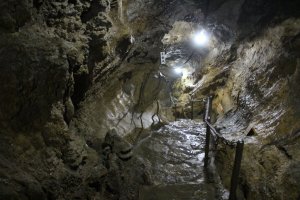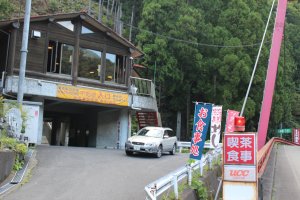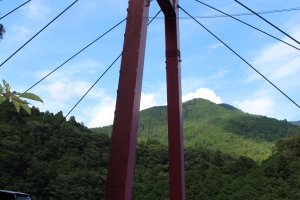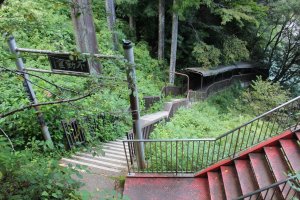The height of the cave’s ceiling more than halved itself dropping to less than the height of my waist. I squatted down and did my best not to hit my head or brush against the mud and water slick walls.
The shape of the passage, leaning over to the left quite far from vertical, and the plastic piping that held the wiring of the cave’s lighting hanging from the ceiling didn’t make the passage any easier. The sound of rushing water came from every direction at once and it grew louder with every step I took. Somewhere in the cave ahead of me was a river or underground waterfall and I was determined to find it.
Caving and Shugendo Buddhism
In the centuries before modernization and tourism brought cement walkways, electric lighting and maintenance to many of Japan’s caves practitioners of Shugendo, Buddhist mountain asceticism, utilized the Fudokutsu Cave in Nara’s Kawakami-mura as a place of worship. It was believed that the perfect darkness and pristine conditions inside the cave cleansed the mind and body. The sound of the underground river and waterfall, believed to be movements of a dragon, served as a test of courage one must pass before being able to embark on long mountain hikes to train in the ways of Shugendo.
Statues of the King of Eleven Faces Fudomyo-sama, the Buddhist deity of discipline, are enshrined in an altar at the entrance to the cave and in the cave’s main chamber next to the Fudo no Taki Waterfall in recognition of the Shugendo faith and history.
A short but impressive red suspension bridge and a brown wooden house on cement stilts mark the entrance to the Kawakami Fudokutsu Cave from National Route 169. Inside the house is a small udon/soba noodles restaurant, an omiyage shop and the ticket counter where one can pay the ¥500 entry fee for the cave.
A long steep stairway then leads the way down the slopes of the Yoshino River valley to the mouth of the Fudokutsu Cave. The cave then goes back about 50 meters into the mountain opening into 4 different chambers along the way. The largest and most impressive of the chambers is the third chamber containing the 2 meter wide Fudo no Taki Waterfall, which cascades down the wall of the cave from a spring near the ceiling.
An altar with a statue of Fudomyo-sama and two dipping cups to cleanse ones hands (and perhaps have a drink), the sound of the falls and the crisp wet feeling of the air complete the experience.
Getting there
The Fudokutsu Cave is in one of the less populated areas of Kawakami-mura and is best accessed by car. Without a car take the Kintetsu Yoshino Line to Yamato Kamiichi Station and board a Yusakari Onsen-Sugi no Yu bound Nara Kotsu Bus. Get off at the Sugi no Yu Michi no Eki and Hotel terminal, transfer to a local bus and get off and the Fudokutsu Bus Stop.
































When I think of it, Fudomyo and caves make sense. He’s about stability, and caves have constant temperature. The shugensha must have found themselves outside time and space there in the darkness.